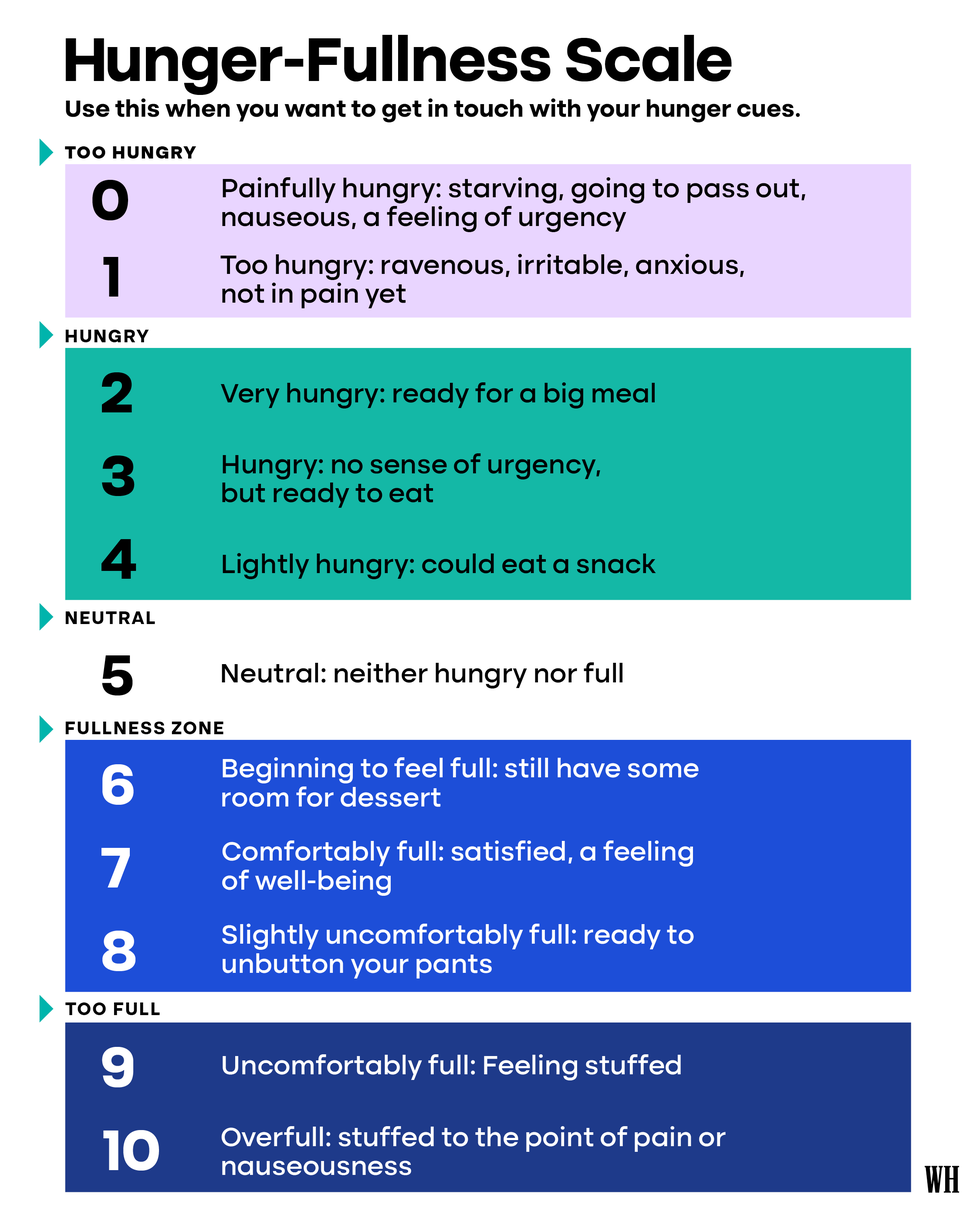How hungry are you right now on a scale of zero to ten? If you’re not super-hungry or super-full, it might be hard to answer. The hunger-fullness scale can help you figure out that number.
The hunger-fullness scale is a tool that helps you get in tune with your body and notice the more nuanced signs of hunger. “A lot of folks who have been dieting their whole lives feel very disconnected from their hunger and fullness and can benefit from reconnecting with them in a mindful way,” says dietitian Emily Van Eck, RD, an intuitive eating counselor in Austin, TX. “When you’re dieting and following rules about what and when and how much to eat, you naturally ignore your body’s cues.”
The scale doesn’t prescribe a right and a wrong way to eat, Van Eck says, but if you’re able to identify where you fall on it, you can get insight into how much to eat and when, and even avoid getting uncomfortably hungry or full. It may seem simple, but for people recovering from years of dieting, it might take some getting used to, says Van Eck. And, it’s a great way to help you practice intuitive eating (we can think of a few reasons why you’d want to).
Here’s how you can use the hunger-fullness scale to get more in tune with your body, improve your relationship with food, and eat more intuitively.
Meet the experts: Emily Van Eck, RD, is a dietitian and intuitive eating counselor in Austin, TX. Vikas Jayadeva, MD, is a primary care physician at Tia.
What is the hunger-fullness scale?
The hunger-fullness scale is a tool that anyone can use to tap into their body’s hunger and fullness cues. If you tend to wait way too long in between meals, overeat, or undereat—you might want to check it out. Basically, it’s a scale from 0 to 10, with each number corresponding to a level of satiety, or how full you are. Zero is incredibly hungry and 10 is painfully full, while five is a true neutral state of comfort.
The scale itself has been used in some form of eating disorder recovery for decades, says Van Eck. The current version (which is used most often) was developed by Evelyn Tribole and Elyse Resch, the creators of the intuitive eating approach.
The hunger-fullness scale can help you practice mindful eating and promote healthier eating patterns overall, says Vikas Jayadeva, MD, a primary care physician at Tia.
Hunger and fullness are about a lot more than just stomachs growling or feeling stuffed. This scale asks you to look for signs of “gentle hunger,” including sensations across your body like headaches or a growling stomach, dropping energy levels, mood changes, or difficulty concentrating, to determine where you fall on it, says Van Eck.
Fullness especially can be hard to notice if you eat quickly or with a lot of distractions, causing you to overeat. And, hunger can be easy to ignore if you’re focusing on everything else in your busy day, leading to uncomfortable side effects like headaches or irritability.
Hunger And Fullness Cues To Look Out For
Examples of hunger cues:
- Pangs of hunger
- Growling or uncomfortable stomach
- Low energy
- Irritability
- Difficulty concentrating
- Lightheadedness
- Nausea
- Headache
- Increased thoughts of food, or cravings
Examples of fullness cues:
- Feeling of satisfaction
- Slowing down in eating
- Tightness in stomach
- Desire to stop eating
- Flavor of food is blunted
How To Use The Hunger-Fullness Scale
Start by just focusing on hunger, says Van Eck. Give yourself a week to get granular with your hunger cues: How often do you eat? When do you typically start to notice you’re hungry? What does that feel like? It should be an exploration, says Van Eck. Check in with yourself at different points of the day to reflect on your fullness and notice any patterns. You can even experiment with new practices—for example, how would it feel to have an afternoon snack to hold you over instead of letting your stomach growl until it’s dinnertime? You can also keep a journal to track how hungry you are before a meal and how full you are after during your exploratory phase.
It’s easiest to use the hunger-fullness scale around meal times. Before you sit down to eat, place yourself somewhere between zero and ten. You can even use your number to determine the portion size of your meal, says Dr. Jayadeva. (If you’re at a four, you might only need a snack, but if you’re at a one or two, it’s time for a full meal.) Then, toward the end of your meal, reassess where you fall on the scale. Ideally, you want to stop at a six or seven, at a comfortable level of fullness, says Dr. Jayadeva. Overall, you want to avoid getting into the uncomfortable or painful territories on both sides of this scale, and being more in tune with your body can help keep you from getting there.
Another thing worth mentioning: You don’t need to use the hunger-fullness scale forever, says Van Eck. It’s a tool that can help you reestablish a connection with your body, but once you get there, you don’t have to be thinking about numbers all the time. And, don’t get discouraged if this is a little tricky at first. “Just because you can’t feel these signals now doesn’t mean that you’re broken,” says Van Eck. “It just means that you need to work on it.”
Who should use the hunger-fullness scale?
Anyone looking to develop a healthier relationship with food—whether you struggle with overeating, dieting, or emotional eating—can benefit from this scale, says Dr. Jayadeva. If you feel like your eating has gotten out of whack, or if you often end up on the extreme sides of hunger and fullness, using this scale can help land you back toward the middle and promote intuitive eating.
The hunger-fullness scale is not recommended right off the bat for people diagnosed with eating disorders, says Van Eck. Because they are more likely to be disconnected from their hunger and fullness signals—and even have a skewed perception of them—the scale might not have the same impact. “They don’t often feel hunger until they’re about to pass out, for example, and feel full after too little food—so if they used [the scale] then, they would still be very under-nourished,” Van Eck says. Instead, they might benefit more from eating at specific, outlined times throughout the day and working with the support of an intuitive eating dietitian and/or therapist before transitioning to intuitive eating on their own, she says.
The scale is also used in weight loss consultations, adds Dr. Jayaveda. “It can aid in weight loss by encouraging individuals to eat mindfully and tune into their body’s needs,” he says. “By focusing on hunger and fullness rather than strict diets, it can promote healthier eating habits and reduce overeating.”
Olivia Luppino is an editorial assistant at Women’s Health where she covers health and fitness. She previously wrote for The Cut, POPSUGAR, and Salon and has written about everything from New York Fashion Week to dating app trends to the United States Women’s National Soccer team (a.k.a. her heroes). When she isn’t writing, Olivia is likely catching up on Bravo shows or running late to barre class.





